Henderson Engineers Caps Off $250 Million Gillette Stadium North End Renovation
Henderson Engineers, a national building systems design firm and member of IAVM, is honored to announce the completion of a $250 million north end renovation of Gillette Stadium, home of the NFL’s New England Patriots and the MLS’ New England Revolution. Standout features include a state-of-the-art curved-radius video board and a new 22-story “Lighthouse.” Concluded this September in alignment with the start of the 2023-2024 NFL season, the project is the largest ever modernization of Gillette Stadium since it opened 21 years ago.
“Gillette Stadium hosts football, soccer, concerts, and other smaller events year-round, so a high level of collaboration was needed across the entire design and construction team to keep the venue operational throughout the two-year north end renovation,” said Tyler Johnson, venue sector practice manager at Henderson Engineers. “While Henderson has worked on various other Gillette Stadium enhancements since 2014, nothing beats the excitement of successfully delivering the most complex and significant transformation yet.”
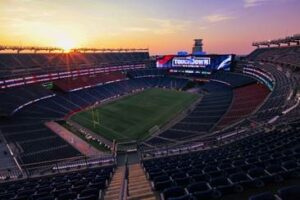
Photo credit: Eric J. Adler/New England Patriots
Spanning 22,200-square-feet, the new high-definition videoboard follows the arc of the stadium and is the largest of its kind in American sports. Audio-video experts from Henderson helped nail down specifications for the jumbotron while its electrical team oversaw controls and power systems. The board was installed in phases during the last two consecutive summers so as to not interfere with the stadium’s large events schedule.
Standing at 220 feet high, the “Lighthouse” includes a 360-degree observation deck offering breathtaking views of the surrounding Boston and Rhode Island region. In collaboration with LAM Partners, Henderson equipped the lights within the tower with color changing and color tuning functionality, providing the capability to illuminate numerous hues and patterns for game day celebrations and other festivities. Henderson furthermore designed for a snow melt system to keep the observation deck accessible to patrons during all seasons.
Other notable Henderson-engineered enhancements include a revamped Enel Plaza, offering a new grand entrance to the venue. Above the plaza sits the new 50,000-square-foot A-P Atrium, a multipurpose space that overlooks the field and functions as a premium club on game days and an event space on other occasions.
“Gillette Stadium is a beloved landmark for millions of fans in the Northeast and across the country. This renovation project further entrenches it as not only as premier destination for sports events, but also for other recreational activities throughout the year,” said Johnson.
In addition to audio-video, electrical, and lighting, Henderson’s full scope of design services for the north end renovation included acoustical consulting, energy modeling, fire protection, mechanical, plumbing, security, and telecom. Populous served as the architect and Suffolk Construction was the general contractor.
IAVM iCommit Membership Campaign
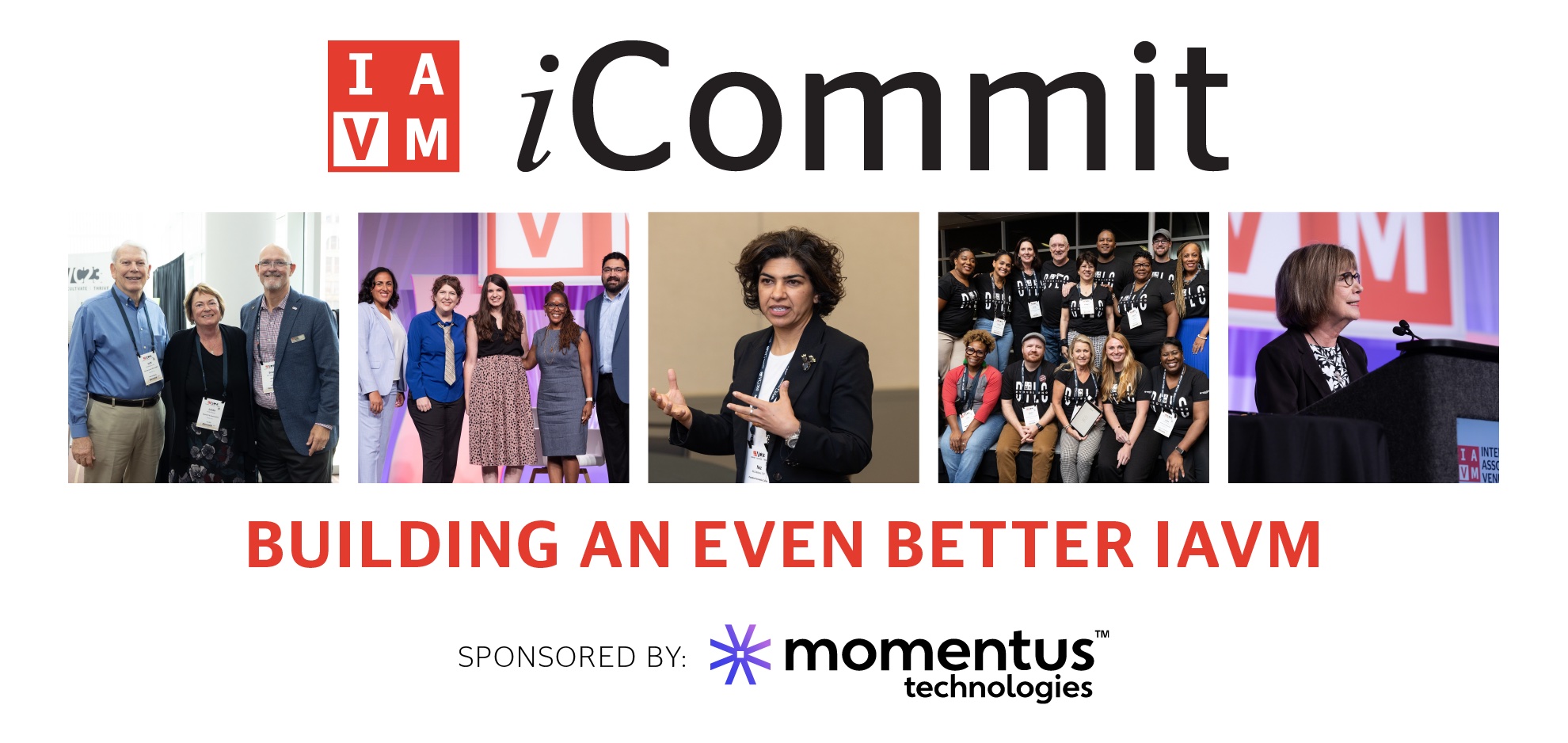
iCommit is IAVM’s annual membership recruitment campaign. Existing members are rewarded for referring new members. Encourage your employees, colleagues, suppliers, interns, and more to become an IAVM member today. Consider adding a new Group Membership for your venue or organization; it is a great way to increase the number of entries in the raffle. Plus, your Professional or Allied referral can save the one-time initiation fee of $150.00.
“Members continue to spread the word about the importance of belonging and help our network, our family, to grow,” said Gina Brydson, director of membership. “The iCommit member referral program added 336 new members last year. It is the best recruitment tool we have – our members telling their stories.”
IAVM’s membership reached an all-time high in July of 7,291 members. The new campaign aims to grow our global community by 10%.
For each new member you refer, you could receive one of the following prizes:
- The grand prize will be a complimentary registration to VenueConnect 2024 (value up to $1,000).
- Win one of five, $500 American Express Gift cards – receive one raffle entry for each new member you refer.
- The IAVM Region that adds the most new members will choose one recipient to apply for the CVP designation; we will waive the $125 application fee (the Region Director will choose the recipient within the winning region).
To ensure you are eligible to win one of the prizes, ask your applicant to do the following:
- List your name in the Application Section titled, “Who Recommended IAVM To You/How Did You Hear About IAVM?” – this ensures you receive credit for the new member.
- For new Professional or Allied membership, the $150 one-time initiation fee will be waived; the applicant must enter the promo code “iCommit” to save the fee.
- Some membership types do not have an initiation fee; the dues will not be discounted.
All winners will be notified in January 2024. Contact membership@iavm.org if you have any questions.
Touhey Testifies Against Speculative Ticketing Before Congressional Subcommittee
Speculative ticket selling should be banned completely, Dave Touhey emphasized to Congressmen and staff. “It is fraud and of no benefit to consumers.”
Touhey, Connett Consulting, was representing IAVM, and by extension, the Fix The Tix Coalition of which IAVM is a member, during testimony before the Subcommittee on Innovation, Data and Commerce Sept. 27 in Washington, D.C. The subcommittee, part of the Committee on Energy and Commerce, was holding a hearing on 14 proposed bills, including three that impact ticketing – the Ticket Act, the Boss and Swift Act, and the Speculative Ticketing Draft.
The hearing was a mid-step in the legislative process. The Representatives were seeking further information from experts in the field. Touhey was speaking to all three bills, not just speculative ticketing. “I was speaking to what was introduced, but said none of it goes far enough. I introduced some insight to why it didn’t go far enough,” Touhey said.
The most compelling part of his original five-minute testimony was by example. He told members how he had gone online to buy tickets to Wu Tang Clan at Capital One Center in Washington. He clicked on the first site that came up, one that had a photo of the building and acted like it was the venue’s site.
He quickly found two tickets in Section 2, Row P for $1,503 all in, but with no seat location. “That’s always an indication it’s not an official sales site, and often a sign that the tickets are speculative,” Touhey testified. That means the seller does not have the tickets in his possession; he is speculating he can get them if he can find a buyer.
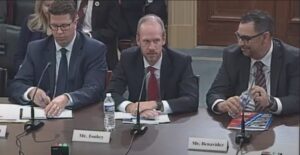
John Breyault, National Consumers League; Dave Touhey, IAVM, and Scott Benevidez, Automobile Service Association
Touhey then went to the venue’s actual site (a venue he once managed) and immediately found Seats 15 and 16 in Section 2, Row P, at an all-in cost of $637.40. The reseller also knew those seats existed, and had Touhey purchased them from him, he presumably would have gone to the venue’s site and bought them to resell to Touhey at a markup of $865.60, a huge profit with no risk to the reseller.
“When I talked about the markup of tickets, going on a secondary site and finding two tickets, then going on a primary site and finding basically the same tickets,and they were marked up almost $800, I looked up to see the reaction. There were quite a few members paying attention to my testimony, and you could see a sort of shock, a ‘Wow, that’s a lot,” Touhey said.
Touhey was given five minutes toward the beginning of the two hour, 30 minute hearing to state his case. After each of the witnesses had their five minutes, the hearing moved to questions, most of which were for further information. “The committee on this is fairly bipartisan,” Touhey noted. “I didn’t feel like I was getting different questions from the left or the right. They were trying to learn.”
Touhey worked with IAVM’s lobbyist, Elizabeth Frazee of TwinLogic Strategies, and IAVM’s Committee on Industry Affairs, of which he is vice chair, on the content of his testimony. Some of it came from his pre-testimony interviews with the committee staff, whom he met with the Friday prior.
“I had some more real-time examples of tickets from a tour that doesn’t go on sale till next week that have tickets ‘available ’on some sites already. I had done it with some of the staff, and they went to the websites themselves,” Touhey said.
“After the hearing, I told someone to go back to your office and look at MorganWallen.com. You can see six to eight tour dates he announced for next spring or summer. He says they don’t go on sale until next week. Then go to secondary sites, and you can see you can buy tickets for those dates, but if you go to the primary site, all you can do is register to purchase those tickets. That’s a speculative ticket,” Touhey said.
The Fix the Tix Coalition’s goal is for them to ban speculative tickets, to make it illegal to list tickets you don’t have, Touhey said. Only the ticket reseller benefits from this large mark up. No one associated with the event does — not the artist, not the venue, and not the promoter, he told the subcommittee.
Touhey said the members didn’t ask as many questions as he’d thought they would and he had prepared for. Nor did they ask some he wished they had, some which his written and spoken testimony somewhat addressed.
THE EXPERIENCE
It was an interesting week for Touhey, who did not know till the Friday prior that he would be testifying on Wednesday morning. He has talked with Congressional staff about different legislative issues over the past year, but never testified at a committee hearing.
“I’ve been in D.C. almost 20 years and only in the past year and a half have I been to the Capitol for anything other than to go to the Visitors Center when guests came in from out of town,” Touhey said. “Now I’ve done the ultimate and testified before Congress.”
He joked that “the most comprehensive study I’ve done of a Bill Becoming a Law was the cartoon “Schoolhouse Rock” on TV as a kid. Some things stick with you. The show had different educational components and one was the How a Bill Becomes a Law song.” Honestly, though, he has more total recall of Schoolhouse Rock’s “Conjunction Junction, What’s Your Function?” on the rules of grammar.
For a bill to become law, it has to be read out of the committee first. Of the three ticketing bills, the Ticket Act has bipartisan support and could move out of committee pretty quickly, he said. The Boss and Swift Act is backed by Democrats and needs Republican support to be fully introduced. The Speculative Ticket Draft could possibly to be incorporated into existing discussion, he added.
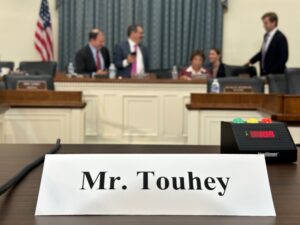
The view of the subcommittee hearing dais from where Dave Touhey sat at the witness table.
Tapped on Friday at 6:30 p.m. to be the witness for IAVM, Touhey then learned the written testimony had to be submitted by 10:30 a.m. Monday. He had a full weekend of sports events and even a camping tripped planned, but he was going to multi-task around that. However, Tropical Storm Ophelia interrupted his outdoor plans, so he hunkered down to write.
After submitting the 1,700-word written testimony, he went to work on the spoken testimony. He had learned from prior experience that it takes five minutes to say 700-800 words. Monday, he worked with IAVM’s lobbyists and Bobby Goldwater, CVE, of Georgetown University on questions he might be asked.
The spoken testimony is a summary of the written testimony and both are part of the official record, he said. In the end, his speech was just under five minutes. “I looked up at the timer towards the end, and I had more time than I thought I was going to,” he remembered, flashing back to the fear he was talking too fast.
Sitting at the witness table, you never know when you are on camera, he added. He quickly realized if the witness to either side of him was talking, he, too, was in the picture. And you always have to be anticipating a question from whatever member is speaking. As one staffer on the Hill told him, being a witness at a Congressional hearing is “like Little League. You don’t want to be caught picking daisies in the outfield.”
The feedback has been good, Touhey said. He even got feedback while at the witness table and was able to sneak a look at his watch to respond to a text from Tammy Koolbeck, CVE.
“The challenging thing about all this advocacy is that unless you’re paying attention to it, you don’t always know it’s coming up, but it’s very important to this industry,” Touhey said. “This showed me a little more how the government works. There’s a lot more behind the scenes than you realize when you watch testimony, not that I’ve watched a lot.”
When being evaluated to be a witness, he met with the staff from both sides. “Staff working on the draft who asked me questions have those answers. Though it didn’t happen in the actual hearing, it’s still part of the process,” Touhey said.
THE MESSAGE
Post hearing, the Industry Affairs Committee met per usual Friday morning, and the subject of deceptive URL’s dominated the conversation.
It’s a nuance Touhey had to explain to a Capitol Hill staffer, who asked, ‘if I go to StubHub, and it says Capital One Arena, is that deceptive?’ No, you are on StubHub, and their logo is on that site. You are looking at their Capital One sales page, but it clearly says StubHub or SeatGeek or Ticketmaster. What we’re trying to target is when you Google Capital One Arena or Arena in Washington, D.C., and up pops a site that is WashingtonArena.com or Washingtontickets.com. When you go on it, it has a logo that looks like the building’s or it has a picture of the building and it has other information about the building, trying to make it look like the venue’s website. That’s deceptive.”
The deceptive site Touhey found for Capital One Arena, says Capital One Arena on it, but in a lot of the language it still says Verizon Center, the arena’s former name. They even have some of the venue’s rules, but they don’t even have an up-to-date bag policy, he added.
Deceptive URL website could have valid tickets, but they are still scalper tickets, still being resold. Or tickets might never come, as happened for some Taylor Swift shows. “Those people had booked flights and hotel rooms to go to an out-of-town stadium to see the show,” Touhey noted in his testimony.
“If you don’t have the actual ticket in your possession, you shouldn’t be able to list it for sale. There should be a fine or punishment if someone’s caught listing a speculative ticket.”
It’s fraud, but it’s a very gray area. The FTC website where consumers report fraud is geared toward issues like stolen credit cards, not speculative tickets.
Another nuance to this issue is that a lot of these speculative sites are “secure” in that they have the lock icon, but that just means they are PCI compliant with credit card processors. “It’s a legitimate credit card account, a legitimate charge. That has nothing to do with the legitimacy of the site,” Touhey said.
Touhey was pleased with points he was able to make and allowed in his observation that none of the bills introduced go far enough in addressing the real issues.
“I think we will have the opportunity to get some of the language changed and addressed for speculative tickets and hopefully get some deceptive URL language inserted. That would be a great first step, but there is a lot that needs to be done to really Fix the Tix problem,” Touhey said. “If we can get a couple of the problems fixed, that’s a lot better than where we are now.”
More than that, he urged all IAVM members to stay involved as this issue progresses.
“When we call or email to ask you to reach out to a politician, a Congressman, or Senator, please help us out,” Touhey urged IAVM members. “Pay attention to ticketing, because if unchecked, the secondary market has a very active lobbying group and will get language and legislation that benefits them under the guise of being beneficial to the consumer. That will really hurt venues, artists,
and consumers.”
For a long time, venues didn’t have to get involved in politics, he believes. “Only recently have there been these types of issues, effecting how we operate as venues. We need to stay ahead of it.”
ASM Global Appoints Alex Bowen as Vice President of Live Entertainment
ASM Global has appointed Alex Bowen as vice president of live entertainment.
In his new role, Bowen will manage event procurement and live-entertainment bookings for ASM Global venues in New Orleans, including Caesars Superdome, Smoothie King Center, Champions Square and Shrine on Airline as well as the new Thunder Ridge Nature’s Arena in Ridgedale, Missouri.
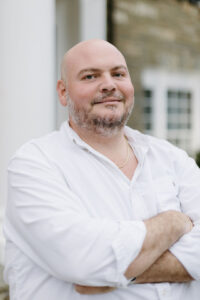
Alex Bowen, Vice President of Live Entertainment, ASM Global
He will also oversee live-content development and booking responsibilities for venues in the Southeast U.S. region, including Brookshire Grocery Arena (Bossier City, Louisiana), Raising Cane’s River Center Arena (Baton Rouge, Louisiana), The Buddy Holly Hall (Lubbock, Texas), Pensacola Bay Center (Pensacola, Florida), Boeing Center at Tech Port (San Antonio, Texas) and more.
With more than a decade of live-event experience, Bowen has expertise in many areas, ranging from concert production, artist management and marketing to operations, event procurement and talent booking. With prior stints at several well-known entertainment venues throughout New Orleans and Baton Rouge, such as the House of Blues and Fillmore, Bowen has become a key player in Louisiana’s entertainment industry, eventually earning his most recent role as senior talent buyer for events promoter Live Nation, overseeing multiple markets and large-scale venues.
“As a native of Louisiana, Bowen has been intertwined in every aspect of the state’s rich live music and entertainment culture and throughout his career has even helped to revive venues with the caliber of talent he brings to the stage,” said John Boyle, ASM Global’s chief content officer. “Between his knowledge of Louisiana and southern U.S. regions and his deep understanding of what it takes to produce great shows, we are confident that his transition to ASM Global will be seamless; and we are excited to have him join our world-class team.”
California Repeals Travel Ban to Anti-LGBTQ States
The fact that California has officially ended its publicly funded travel ban to states with laws that discriminate against LGBTQ+ people is good news for all venues in those states, particularly meetings and sports venues. The actual impact of the 2016 legislation had been supplanted already by COVID-19, post-COVID policies and other state’s legislative action, but nevertheless, it opened the gates to some prospecting that had been on hold for years.
Governor Gavin Newsom signed California’s Senate Bill 447, known as the BRIDGE Project, Sept. 13. It repeals the 2016 law that banned state-sponsored travel to as many as 26 states, the number reported to discriminate on the basis of “sexual orientation, gender identity or gender expression” per the American Civil Liberties Union.
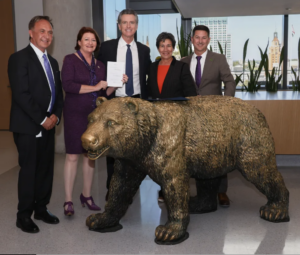
Governor Newsom alongside Assemblymember Zbur, Pro Tem Atkins, Senator Eggman and Assemblymember Ward for SB 447 signing (left to right.)
Seven years ago, North Carolina venues were hit hard by California’s ban because of their own state’s HB2, dubbed the “bathroom bill” but officially the Public Facilities Privacy & Security Act, which, among other mandates, compelled schools and state and local government facilities containing single-gender bathrooms to limit access to people of the corresponding sex as listed on their birth certificate.
When that 2016 bill was signed into law by N.C. Governor Pat McCrory, the sales team at the Raleigh Convention Center took a hit. Mara Craft, currently director of sales there, remembers: “Honestly, it was a midnight session. I remember our former director of sales texted me at 11 P.M. saying, ‘This is not going to be good.’ That morning it’s like our emails and phones had exploded.”
“It was hard that first year. Even if you traveled, we had a rule you couldn’t travel alone, because there were folks that would take it out on us, sales people or service people, because they were so — rightly so — upset about it. Then other states made poor decisions, and it became less and less prominent. That [HB2] law sunsetted, but people just don’t know that.”
Kerry Painter, CVE, CEM, CMP, director of the Raleigh complex, summarized the impact of California’s new legislation succinctly: “If you were still leery or holding a grudge, it takes it away.”
There is a list of HB2 groups who would not consider Raleigh until California and other boycotts go away, “and we will add them back into our prospecting list. A lot of them are in D.C., so the CVB and our team have already started reaching out to them,” Craft said.
The impact of COVID overshadowed any boycotting that was obvious, she added, but there were still associations “we would chat with that would say, ‘Oh, we have a big California contingency that wouldn’t be able to travel there.’ Typically, that happened in higher ed or government.”
Timing is coincidentally great for arenas hosting sports, and North Carolina hosts more than its fair share of college sports tournaments. With Stanford and Cal joining the ACC in 2024, it’s even more apropos.
Pressure from sports organizations, like the ACC, had a lot to do with dropping the original HB2, Craft noted, adding that they were lucky that Raleigh is a progressive city and had other legislation and ordinances that protected them. Still, the state as a whole was looked on unfavorably, which hurt places like Greensboro Coliseum Complex early on.
Scott Johnson, deputy director in Greensboro, recalled the venue lost a whole year of NCAA tournaments when HB2 and the resulting boycotts hit. When the bill was repealed, most of Greensboro’s youth sports and college basketball came back.
“Every state had a different rule or different tolerance for what they would accept. North Carolina took the brunt of it for awhile,” Johnson said.
Even with business back, Gov. Newsom’s move is “symbolically a good move,” Johnson said.
Not only did Greensboro lose NCAA events the year of HB2, they lost the next scheduled series in 2020 because of COVID.
“We just had a 2022 Women’s Regional and 2023 Men’s First and Second round, and it all went flawlessly. There were no problems from any states,” Johnson said.
California’s new law, which is effective immediately, replaces the travel prohibition with an outreach campaign that encourages LGBTQ acceptance and inclusivity.
“In the face of a rising tide of anti-LGBTQ+ hate, this measure helps California’s message of acceptance, equality, and hope reach the places where it is most needed,” Newsom said in a news release.
Do you want to receive a Front Row News weekly digest?
Categories
- Allied (861)
- Architecture (147)
- Arenas (747)
- Career (897)
- Convention Centers (895)
- Education (623)
- Events (1,544)
- Food & Beverage (193)
- Foundation (113)
- Guest Experience (1,496)
- Industry News (2,270)
- Leadership (1,888)
- Marketing (150)
- Membership (2,000)
- Music (213)
- Performing Arts Centers (454)
- Professional Development (409)
- Research (127)
- Safety & Security (442)
- Sports (763)
- Stadiums (608)
- Student (159)
- Technology (516)
- Ticketing (92)
- Touring (82)
- Trends (364)
- Uncategorized (745)
- Universities (218)
- Video (25)
- Young Professional (198)
Twitter Feed
- Twitter feed loading
Recent Posts
- VenuWorks Selected To Manage Historic Paramount Arts Center In Ashland
- Miami Beach Convention Center Wraps a Milestone Year
- Venuworks and ATG Entertainment Selected to Manage Fresno Convention and Entertainment Center
- Seattle Convention Center Announces Strategic Leadership Appointment and Growth Initiatives for 2026
- Peggy Daidakis Humbly Made Convention Center History
Categories
- Allied
- Architecture
- Arenas
- Career
- Convention Centers
- Education
- Events
- Food & Beverage
- Foundation
- Guest Experience
- Industry News
- Leadership
- Marketing
- Membership
- Music
- Performing Arts Centers
- Professional Development
- Research
- Safety & Security
- Sports
- Stadiums
- Student
- Technology
- Ticketing
- Touring
- Trends
- Uncategorized
- Universities
- Video
- Young Professional
Archives
- January 2026
- December 2025
- November 2025
- October 2025
- September 2025
- August 2025
- July 2025
- June 2025
- May 2025
- April 2025
- March 2025
- February 2025
- January 2025
- December 2024
- November 2024
- October 2024
- September 2024
- August 2024
- July 2024
- June 2024
- May 2024
- April 2024
- March 2024
- February 2024
- January 2024
- December 2023
- November 2023
- October 2023
- September 2023
- August 2023
- July 2023
- June 2023
- May 2023
- April 2023
- March 2023
- February 2023
- January 2023
- December 2022
- November 2022
- October 2022
- September 2022
- August 2022
- July 2022
- June 2022
- May 2022
- April 2022
- March 2022
- February 2022
- January 2022
- December 2021
- November 2021
- October 2021
- September 2021
- August 2021
- July 2021
- June 2021
- May 2021
- April 2021
- March 2021
- February 2021
- January 2021
- December 2020
- November 2020
- October 2020
- September 2020
- August 2020
- July 2020
- June 2020
- May 2020
- April 2020
- March 2020
- February 2020
- January 2020
- December 2019
- November 2019
- October 2019
- September 2019
- August 2019
- July 2019
- June 2019
- May 2019
- April 2019
- March 2019
- February 2019
- January 2019
- December 2018
- November 2018
- October 2018
- September 2018
- August 2018
- July 2018
- June 2018
- May 2018
- April 2018
- March 2018
- February 2018
- January 2018
- December 2017
- November 2017
- October 2017
- September 2017
- August 2017
- July 2017
- June 2017
- May 2017
- April 2017
- March 2017
- February 2017
- January 2017
- December 2016
- November 2016
- October 2016
- September 2016
- August 2016
- July 2016
- June 2016
- May 2016
- April 2016
- March 2016
- February 2016
- January 2016
- December 2015
- November 2015
- October 2015
- September 2015
- August 2015
- July 2015
- June 2015
- May 2015
- April 2015
- March 2015
- February 2015
- January 2015
- December 2014
- November 2014
- October 2014
- September 2014
- August 2014
- July 2014
- June 2014
- May 2014
- April 2014
- March 2014
- February 2014
- January 2014
- December 2013
- November 2013
- October 2013
- September 2013
- August 2013
- July 2013
- June 2013
- May 2013
- April 2013
- March 2013
- February 2013
- January 2013
- May 2012
- March 2012
- December 2011
- November 2011
- October 2011
Recent Comments
- Frank Bradshaw, Ph.D., CVE on John Meyer, CVE, a Tireless Advocate of Certification for Venue Professionals, Has Died
- Neil Sulkes on Hilary Hartung, Friend to Many in Venue Marketing, Has Left Us
- Jason Parker, CVE on The Devastation of Hurricane Helene and How We Can Support One Another
- Larry Perkins on Touhey Testifies Against Speculative Ticketing Before Congressional Subcommittee
- Peter Secord on Major Players for Planned Elkhart Amphitheater Were in the Mix at VenueConnect
